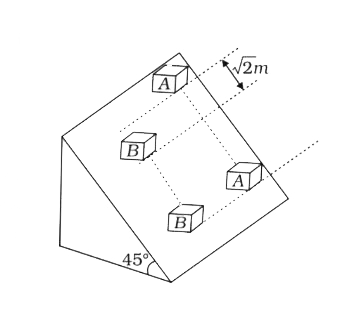Purine nucleosides have
5-3 phosphodiester bond
1-9 glycosidic linkage
1-1' glycosidic linkage
H-bonds
The correct Answer is:B
To solve the question regarding purine nucleosides, we need to understand the structure of nucleosides and the types of linkages involved.
1. Understand Nucleosides:
- Nucleosides are composed of two main components: a nitrogenous base and a sugar molecule (either ribose in RNA or deoxyribose in DNA). They do not contain phosphate groups.
2. Identify the Types of Nitrogenous Bases:
- There are two categories of nitrogenous bases: purines and pyrimidines.
- Purines include adenine and guanine, which have a nine-membered ring structure.
- Pyrimidines include cytosine, thymine, and uracil, which have a six-membered ring structure.
3. Analyze the Options:
- Option A: "5 prime to 3 prime phosphodiester bond" - This is incorrect because nucleosides do not have phosphate groups; phosphodiester bonds are found in nucleotides.
- Option B: "1 prime to 9 prime glycosidic linkage" - This is correct for purine nucleosides. The nitrogenous base (purine) forms a glycosidic bond with the sugar at the 1' carbon of the sugar and the 9th nitrogen of the purine.
- Option C: "1 to 1 prime glycosidic linkage hydrogen bond" - This is incorrect for purines. While pyrimidines have a 1' to 1' linkage, purines specifically have a 1' to 9' linkage.
4. Conclusion:
- The correct answer is Option B, which states that purine nucleosides have a "1 prime to 9 prime glycosidic linkage."
- Nucleosides are composed of two main components: a nitrogenous base and a sugar molecule (either ribose in RNA or deoxyribose in DNA). They do not contain phosphate groups.
- There are two categories of nitrogenous bases: purines and pyrimidines.
- Purines include adenine and guanine, which have a nine-membered ring structure.
- Pyrimidines include cytosine, thymine, and uracil, which have a six-membered ring structure.
- Option A: "5 prime to 3 prime phosphodiester bond" - This is incorrect because nucleosides do not have phosphate groups; phosphodiester bonds are found in nucleotides.
- Option B: "1 prime to 9 prime glycosidic linkage" - This is correct for purine nucleosides. The nitrogenous base (purine) forms a glycosidic bond with the sugar at the 1' carbon of the sugar and the 9th nitrogen of the purine.
- Option C: "1 to 1 prime glycosidic linkage hydrogen bond" - This is incorrect for purines. While pyrimidines have a 1' to 1' linkage, purines specifically have a 1' to 9' linkage.
- The correct answer is Option B, which states that purine nucleosides have a "1 prime to 9 prime glycosidic linkage."
Topper's Solved these Questions
Similar Questions
Knowledge Check
An acid soluble compound formed by phosphorylation of nucleoside is called
Anitrogen baseBadenineCsugar phosphateDnucleotide.The component present in both nucleotides and nucleosides is
AsugarBphosphateCnitrogenous baseDboth (a) and (b)
In nucleosides, both base and sugar are joined by
View SolutionIn nucleoside, a base is attached at 1' position of sugar moiety. Nucleotide is formed by linking of phosphoric acid unit to the sugar unit of nucleoside. At which position of sugar unit is the phosphoric acid linked in a nucleoside to give a nucleotide?
View SolutionAn acid soluble compound formed by phyosphorylation of nucleoside is called
View SolutionBonding between deoxyribose and base in pyrimidine nucleoside molecule is :-
View SolutionWhich moieties of nucleosides are involved in the formation of phosphodiester linkage present in dinucleotides? What does the word diester in the name of linkage indicate? Which acid is involved in the formation of this linkage?
View SolutionTwo identical blocks A and B of equal masses are placed on rough inclined plane as shown in the figure. Initially the block A is √2m behind the block B. Coefficient of kinetic friction for the blocks A and B are 0.2 and 0.3 respectively (g=10m/s2). By the time the two blocks come on the same line on the inclined plane if they are released simultaneously, the distance moved by B is βm Find the value of β

View Solution
